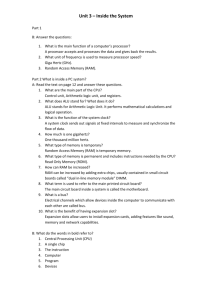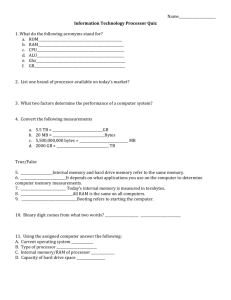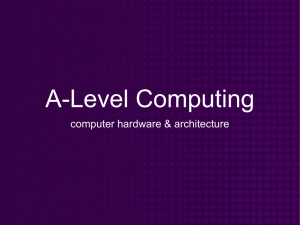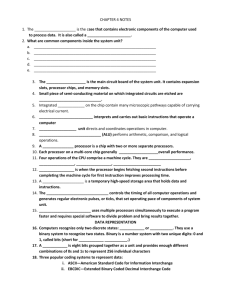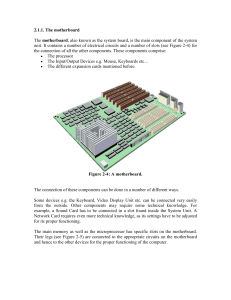Chapter 4
advertisement
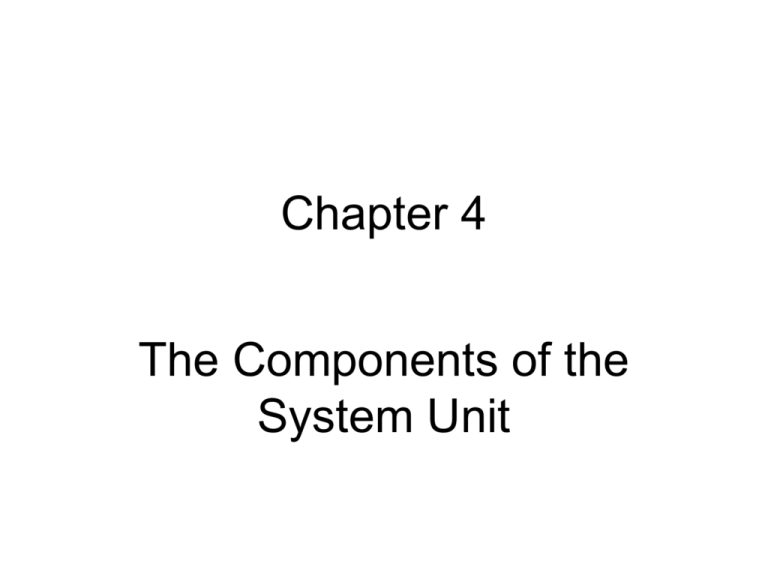
Chapter 4 The Components of the System Unit The System Unit It is a case that contains electronic components of the computer used to process data Sometimes called the chassis It is made of metal or plastic and protects the internal electronic components from damage. The System Unit • What are common components inside the system unit? power supply drive bays Processor Memory Adapter cards Sound card Modem card Video card Network card Ports Drive bays Power supply processor memory ports sound card network card modem card video card The System Unit • What is the motherboard? Main circuit board in system unit Many electronic components attach to the motherboard; others are built into it. Contains adapter cards, processor chips, and memory chips Also called system board The System Unit • What is a chip? Small piece of semi-conducting material on which integrated circuits are etched Integrated circuits contain many microscopic pathways capable of carrying electrical current Chips are packaged so they can be attached to a circuit board dual inline packages (DIP) holds memory chips pin grid array (PGA) package holds processor chips Processor • What is the central processing unit Interprets (CPU)?and carries Processor out basic instructions that operate a computer Control unit directs and coordinates operations in computer Arithmetic logic unit Input (ALU) performs Devices arithmetic, comparison, and logical operations Also called the processor Control Control Unit Unit Arithmetic Arithmetic Logic Logic Unit Unit (ALU) (ALU) Instructions Data Information Data Memory Instructions Data Information Storage Devices Information Output Devices Processor • What is a machine cycle? Four operations of the CPU comprise a machine cycle Step 1. Fetch Obtain program instruction or data item from memory Memory Step 2. Decode Step 4. Store Translate instruction into commands Write result to memory Processor ALU Step 3. Execute Carry out command Control Unit Processor • What is the system clock? Controls timing of all computer operations Generates regular electronic pulses, or ticks, that set operating pace of components of system unit Each tick is a clock cycle Pace of system clock is clock speed Most clock speeds are in the gigahertz (GHz) range (1 GHz = one billion ticks of system clock per second) Processor speed can also be measured in millions of instructions per second (MIPS) Processor • What is a coprocessor? Chip that assists processor in performing specific tasks One type is a floating-point coprocessor, also known as a math or numeric coprocessor Processor • What is parallel processing? Using multiple processors simultaneously to execute a program faster Requires special software to divide problem and bring results together Control Processor Processor 1 Processor 2 Processor 3 Processor 4 Memory Memory Memory Memory Results combined Data Representation • How do computers represent data? Most computers are digital Recognize only two discrete states: on or off Use a binary system to recognize two states Use Number system with two unique digits: 0 and 1, called bits (short for binary digits) Data Representation • What is a byte? Eight bits grouped together as a unit Provides enough different combinations of 0s and 1s to represent 256 individual characters Numbers Uppercase and lowercase letters Punctuation marks Memory • What is memory? Electronic components that store instructions, data, and results Consists of one or more chips on motherboard or other circuit board Each byte stored in unique location called an address. Memory • What is random access memory (RAM)? Memory chips that can be read from and written to by processor Also called main memory or primary storage Most RAM is volatile, it is lost when computer’s power is turned off The more RAM a computer has, the faster it responds Memory • What are two basic types of RAM chips? Most common type Faster variations of DRAM are SDRAM and RDRAM Static RAM Dynamic (SRAM) RAM (DRAM) Used for special applications such as cache Faster and more reliable than DRAM chips • Future: Magnetoresistive RAM (MRAM) Memory dual inline memory module • Where does memory reside? Resides on small circuit board called memory module Memory slots on motherboard hold memory modules memory chip memory slot Memory • How much RAM does an application require? System Requirements Software package typically indicates RAM requirements For optimal performance, you need more than minimum specifications Windows® XP Home Edition/Professional • Intel Pentium processor at 233MHZ or higher • AMD K6 (Athlon Duron Family processor at 233MHZ or higher • 64 MB of RAM Memory • How much RAM do you need? Depends on type of applications you intend to run on your computer RAM Use 128 to 256 MB • Home and business users managing personal finance • Using standard application software such as word processing • Using educational or entertainment CD-ROMs • Communicating with others on the Web 256 to 1 GB • Users requiring more advanced multimedia capabilities • Running number-intensive accounting, financial, or spreadsheet programs • Using voice recognition • Working with videos, music, and digital imaging • Creating Web sites • Participating in video conferences • Playing Internet games 1 GB and up • Power users creating professional Web sites • Running sophisticated CAD, 3D design, or other graphics-intensive software • What is cache? Memory Helps speed computer processes by storing frequently used instructions and data Also called memory cache L1 cache built into processor L2 cache slower but has larger capacity L2 advanced transfer cache is faster, built directly on processor chip L3 cache is separate from processor chip on motherboard (L3 is only on computers that use L2 advanced transfer cache) Memory • What is read-only memory (ROM)? Memory chips that store permanent data and instructions Nonvolatile memory, it is not lost when computer’s power is turned off EEPROM (electrically Three types: erasable programmable read-only memory)— Firmware— Type of PROM Manufactured with containing microcode PROM permanently written programmer data, instructions, (programmable can erase read-only or information memory)— Blank ROM chip onto which a programmer can write permanently Memory What is flash memory? Nonvolatile memory that can be erased electronically and reprogrammed Used with PDAs, digital cameras, digital cellular phones, music players, digital voice recorders, printers, Internet receivers, and pagers Expansion Slots & Adapter Cards Types of Adapter Cards • What is an adapter card? Enhances system unit or provides connections to external devices called peripherals Also called an expansion card Expansion Slots & Adapter Cards • What is an expansion slot? An opening, or socket, on the motherboard that can hold an adapter card With Plug and Play, the computer automatically configures cards and other devices as you install them Ports and Connectors Port connects external devices to system unit Connector joins cable to peripheral Available in one of two genders: male and female Ports and Connectors • What is a serial port? Transmits one bit of data at a time Connects slow-speed devices, such as mouse, keyboard, modem Ports and Connectors • What is a parallel port? Connects devices that can transfer more than one bit at a time, such as a printer Ports and Connectors • What are USB ports? USB (universal serial bus) port can connect up to 127 different peripherals together with a single connector type PCs typically have four to eight USB ports on front or back of the system unit Single USB port can be used to attach multiple peripherals in a daisy chain Buses • What is a bus? Channel that allows devices inside computer to communicate with each other System bus connects processor and RAM Bus width determines number of bits transmitted at one time Word size is the number of bits processor can interpret and execute at a given time
